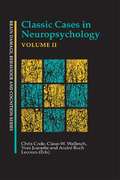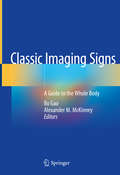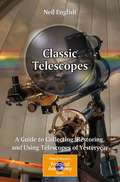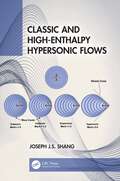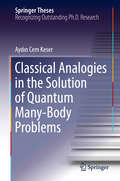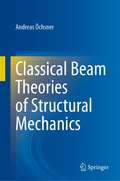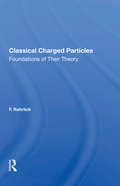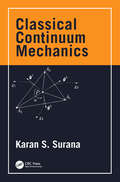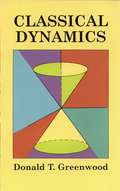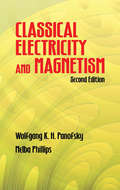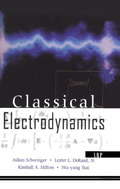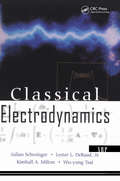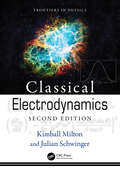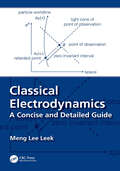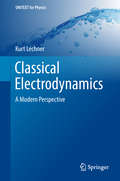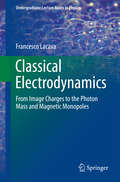- Table View
- List View
Classic Cases in Neuropsychology, Volume II (Brain, Behaviour and Cognition)
by Chris Code Yves Joanette Claus-W. Wallesch AndrÉ Roch LecoursFrom a contemporary perspective, Classic Cases in Neuropsychology, Volume II reviews important and significant cases described in historical and modern literature where brain damage has been sustained. The single case study has always been of central importance to the discipline of neuropsychology. Cognitive neuropsychology and cognitive neurolinguistics search for universal structures in thought processes, and single patients are an important means to that end. The role of the single case study in the historical development of the field and its increasing contribution to contemporary work is therefore recognised as crucial.This follow-up to the successful Classic Cases in Neuropsychology (1996) brings together more of the important case investigations which have shaped the way we think about the relationships between brain, behaviour and cognition. The book includes cases from the rich history of neuropsychology as well as important contemporary case studies in the fields of memory, language and perception. Some of the cases described are rare, some are seminal in the field, many were the first of their type to be described and gave rise to new theories, and some are still controversial. As in the first volume, each chapter highlights the relevance of the case to the development of neuropsychology and discusses the theoretical implication of the findings.Classic Cases in Neuropsychology, Volume II will be essential reading for students and researchers alike in the fields of neuropsychology and neuroscience. It will also be of interest to speech and language pathologists, therapists and clinicians in this area.
Classic Imaging Signs: A Guide to the Whole Body
by Bo Gao Alexander M. McKinneyThis book systematically summarizes classic imaging signs' characteristics and theory for whole body imaging, serving as a clinical guide for the understanding, prevention, and diagnosis of miscellaneous entities. In recent years, with the rapid evolution of modern imaging modalities, radiology has secured an irreplaceable role in diagnosis within standard clinical practice and being familiar with radiological signs has become essential.The book provides a multimodality review of more than 300 commonly utilized radiologic signs in radiography, CT, MRI, US, angiography, and nuclear medicine, including PET-CT. It is designed to enhance recognition of specific imaging patterns and enable the image interpreter to confidently reach an accurate diagnosis. Divided into ten chapters dedicated to different anatomic areas, each sign includes detailed discussion that explains the history and meaning of the descriptive or metaphoric sign, alongside illustrative photos for memory aid and clarification. Uniquely written from a practical point of view, each case leads you through a radiology expert’s thought process in analyzing the classic signs with considerations of common misinterpretations and imaging pitfalls. The cases then highlight clinical presentation, relevant pathology, anatomy, physiology, and pertinent imaging features of common disease processes. Key information is distilled into succinct, bulleted points with detailed illustrations and images.This book is an ideal reference and review for practicing radiologists, as well as trainees preparing for licensing examinations.
Classic Telescopes: A Guide to Collecting, Restoring, and Using Telescopes of Yesteryear (The Patrick Moore Practical Astronomy Series)
by Neil EnglishClassic telescopes are of interest to amateur astronomers for a variety of reasons. There are the dedicated collectors, but there are also many amateurs who love the nostalgia they inspire. These telescopes "feel" different from any contemporary telescope and perhaps have a unique ability to reconnect the owner to a bygone age of craftmanship. This book takes a look at traditional telescopes built by the great instrument makers of the 18th and 19th centuries, particularly the dynastic telescope makers, including Dollond, Alvan Clark, Thomas Cooke & Sons, and Carl Zeiss. Also included are lesser luminaries such as John Brashear, John Calver, William Wray, Henry Fitz, and William Henry Mogey. 'Classic Telescopes' covers the key features of the telescopes designed by these manufacturers, and shows how a heady combination of market trends, instrument condition, and pedigree will dictate their prices at auction. 'Classic Telescopes' also shows the reader how to find real bargains! Interviews with top classic telescope collectors (and users) provide the best tips of prospecting for a genuine acquisition.
Classic and High-Enthalpy Hypersonic Flows
by Joseph J.S. ShangClassic and High-Enthalpy Hypersonic Flows presents a complete look at high-enthalpy hypersonic flow from a review of classic theories to a discussion of future advances centering around the Born-Oppenheim approximation, potential energy surface, and critical point for transition. The state-of-the-art hypersonic flows are defined by a seamless integration of the classic gas dynamic kinetics with nonequilibrium chemical kinetics, quantum transitions, and radiative heat transfer. The book is intended for graduate students studying advanced aerodynamics and taking courses in hypersonic flow. It can also serve as a professional reference for practicing aerospace and mechanical engineers of high-speed aerospace vehicles and propulsion system research, design, and evaluation. Features Presents a comprehensive review of classic hypersonic flow from the Newtonian theory to blast wave analogue. Introduces nonequilibrium chemical kinetics to gas dynamics for hypersonic flows in the high-enthalpy state. Integrates quantum mechanics to high-enthalpy hypersonic flows including dissociation and ionization. Covers the complete heat transfer process with radiative energy transfer for thermal protection of earth reentry vehicle. Develops and verifies the interdisciplinary governing equations for understanding and analyzing realistic hypersonic flows.
Classical Analogies in the Solution of Quantum Many-Body Problems (Springer Theses)
by Aydın Cem KeserThis book addresses problems in three main developments in modern condensed matter physics– namely topological superconductivity, many-body localization and strongly interacting condensates/superfluids–by employing fruitful analogies from classical mechanics. This strategy has led to tangible results, firstly in superconducting nanowires: the density of states, a smoking gun for the long sought Majorana zero mode is calculated effortlessly by mapping the problem to a textbook-level classical point particle problem. Secondly, in localization theory even the simplest toy models that exhibit many-body localization are mathematically cumbersome and results rely on simulations that are limited by computational power. In this book an alternative viewpoint is developed by describing many-body localization in terms of quantum rotors that have incommensurate rotation frequencies, an exactly solvable system. Finally, the fluctuations in a strongly interacting Bose condensate and superfluid, a notoriously difficult system to analyze from first principles, are shown to mimic stochastic fluctuations of space-time due to quantum fields. This analogy not only allows for the computation of physical properties of the fluctuations in an elegant way, it sheds light on the nature of space-time. The book will be a valuable contribution for its unifying style that illuminates conceptually challenging developments in condensed matter physics and its use of elegant mathematical models in addition to producing new and concrete results.
Classical Beam Theories of Structural Mechanics
by Andreas ÖchsnerThis book provides a systematic and thorough overview of the classical bending members based on the theory for thin beams (shear-rigid) according to Euler-Bernoulli, and the theories for thick beams (shear-flexible) according to Timoshenko and Levinson. The understanding of basic, i.e., one-dimensional structural members, is essential in applied mechanics. A systematic and thorough introduction to the theoretical concepts for one-dimensional members keeps the requirements on engineering mathematics quite low, and allows for a simpler transfer to higher-order structural members. The new approach in this textbook is that it treats single-plane bending in the x-y plane as well in the x-z plane equivalently and applies them to the case of unsymmetrical bending. The fundamental understanding of these one-dimensional members allows a simpler understanding of thin and thick plate bending members.Partial differential equations lay the foundation to mathematically describe the mechanical behavior of all classical structural members known in engineering mechanics. Based on the three basic equations of continuum mechanics, i.e., the kinematics relationship, the constitutive law, and the equilibrium equation, these partial differential equations that describe the physical problem can be derived. Nevertheless, the fundamental knowledge from the first years of engineering education, i.e., higher mathematics, physics, materials science, applied mechanics, design, and programming skills, might be required to master this topic.
Classical Charged Particles
by Fritz RohrlichWidely-discussed in the theory of classical point charges are the difficulties of divergent self-energy, self-accelerating solutions, and pre-acceleration. This book explains the theory in the context of quantum electrodynamics, the neutral particle limit, and coherence with neighboring theories.
Classical Continuum Mechanics (Applied and Computational Mechanics)
by Karan S. SuranaThis book provides physical and mathematical foundation as well as complete derivation of the mathematical descriptions and constitutive theories for deformation of solid and fluent continua, both compressible and incompressible with clear distinction between Lagrangian and Eulerian descriptions as well as co- and contra-variant bases. Definitions of co- and contra-variant tensors and tensor calculus are introduced using curvilinear frame and then specialized for Cartesian frame. Both Galilean and non-Galilean coordinate transformations are presented and used in establishing objective tensors and objective rates. Convected time derivatives are derived using the conventional approach as well as non-Galilean transformation and their significance is illustrated in finite deformation of solid continua as well as in the case of fluent continua. Constitutive theories are derived using entropy inequality and representation theorem. Decomposition of total deformation for solid and fluent continua into volumetric and distortional deformation is essential in providing a sound, general and rigorous framework for deriving constitutive theories. Energy methods and the principle of virtual work are demonstrated to be a small isolated subset of the calculus of variations. Differential form of the mathematical models and calculus of variations preclude energy methods and the principle of virtual work. The material in this book is developed from fundamental concepts at very basic level with gradual progression to advanced topics. This book contains core scientific knowledge associated with mathematical concepts and theories for deforming continuous matter to prepare graduate students for fundamental and basic research in engineering and sciences. The book presents detailed and consistent derivations with clarity and is ideal for self-study.
Classical Dynamics (Dover Books On Physics Series)
by Donald T. GreenwoodSince Lagrange laid the foundation of analytical dynamics some two centuries ago, the discipline has continued to evolve and develop, embracing the theories of Hamilton and Jacobi, Einstein's relativity theory and advanced theories of classical mechanics.This text proposes to give graduate students in science and engineering a strong background in the more abstract and intellectually satisfying areas of dynamical theory. It is assumed that students are familiar with the principles of vectorial mechanics and have some facility in the use of this theory for analysis of systems of particles and for rigid-body rotation in two and three dimensions.After a concise review of basic concepts in Chapter 1, the author proceeds from Lagrange's and Hamilton's equations to Hamilton-Jacobi theory and canonical transformations. Topics include d'Alembert's principle and the idea of virtual work, the derivation of Langrange's equation of motion, special applications of Lagrange's equations, Hamilton's equations, the Hamilton-Jacobi theory, canonical transformations and an introduction to relativity.Problems included at the end of each chapter will help the student greatly in solidifying his grasp of the principal concepts of classical dynamics. An annotated bibliography at the end of each chapter, a detailed table of contents and index, and selected end-of-chapter answers complete this highly instructive text.
Classical Dynamics: A Contemporary Approach
by Jorge V. José Eugene J. SaletanRecent advances in the study of dynamical systems have revolutionized the way that classical mechanics is taught and understood. Classical Dynamics: A Contemporary Approach is a new and comprehensive textbook that provides a complete description of this fundamental branch of physics. The authors cover all the material that one would expect to find in a standard graduate course: Lagrangian and Hamiltonian dynamics, canonical transformations, the Hamilton-Jacobi equation, perturbation methods, and rigid bodies. They also deal with more advanced topics such as the relativistic Kepler problem, Liouville and Darboux theorems, and inverse and chaotic scattering. A key feature of the book is the early introduction of geometric (differential manifold) ideas, as well as detailed treatment of topics in nonlinear dynamics (such as the KAM theorem) and continuum dynamics (including solitons). The book contains many worked examples and over 200 homework exercises. It will be an ideal textbook for graduate students of physics, applied mathematics, theoretical chemistry, and engineering, as well as a useful reference for researchers in these fields. A solutions manual is available exclusively for instructors.
Classical Electricity and Magnetism (Dover Books on Physics)
by Melba Phillips Wolfgang K. PanofskyCompact, clear, and precise in its presentation, this distinguished, widely used textbook offers graduate students and advanced undergraduates a diverse and well-balanced selection of topics.Subjects include the electrostatic field in vacuum; boundary conditions and relation of microscopic to macroscopic fields; general methods for the solution of potential problems, including those of two and three dimensions; energy relations and forces in the electrostatic field; steady currents and their interaction; magnet materials and boundary value problems; and Maxwell’s equations. Additional topics include energy, force, and momentum relations in the electromagnetic field; the wave equation and plane waves; conducting fluids in a magnetic field; waves in the presence of metallic boundaries; the inhomogeneous wave equation; the experimental basis for the theory of special relativity; relativistic kinematics and the Lorentz transformation; covariance and relativistic mechanics; covariant formulation of electrodynamics; and the Liénard-Wiechert potentials and the field of a uniformly moving electron.The text concludes with examinations of radiation from an accelerated charge; radiation reaction and covariant formulation of the conservation laws of electrodynamics; radiation, scattering, and dispersion; the motion of charged particles in electromagnetic fields; and Hamiltonian formulation of Maxwell’s equations.
Classical Electrodynamics
by Julian Schwinger Lester L. Deraad Jr. Kimball Milton Wu-Yang Tsai Joyce NortonClassical Electrodynamics captures Schwinger's inimitable lecturing style, in which everything flows inexorably from what has gone before. Novel elements of the approach include the immediate inference of Maxwell's equations from Coulomb's law and (Galilean) relativity, the use of action and stationary principles, the central role of Green's functions both in statics and dynamics, and, throughout, the integration of mathematics and physics. Thus, physical problems in electrostatics are used to develop the properties of Bessel functions and spherical harmonics. The latter portion of the book is devoted to radiation, with rather complete treatments of synchrotron radiation and diffraction, and the formulation of the mode decomposition for waveguides and scattering. Consequently, the book provides the student with a thorough grounding in electrodynamics in particular, and in classical field theory in general, subjects with enormous practical applications, and which are essential prerequisites for the study of quantum field theory.An essential resource for both physicists and their students, the book includes a "Reader's Guide," which describes the major themes in each chapter, suggests a possible path through the book, and identifies topics for inclusion in, and exclusion from, a given course, depending on the instructor's preference. Carefully constructed problems complement the material of the text, and introduce new topics. The book should be of great value to all physicists, from first-year graduate students to senior researchers, and to all those interested in electrodynamics, field theory, and mathematical physics.The text for the graduate classical electrodynamics course was left unfinished upon Julian Schwinger's death in 1994, but was completed by his coauthors, who have brilliantly recreated the excitement of Schwinger's novel approach.
Classical Electrodynamics
by Julian Schwinger Lester L. Deraad Jr. Kimball Milton Wu-Yang TsaiClassical Electrodynamicscaptures Schwinger’s inimitable lecturing style, in which everything flows inexorably from what has gone before. Novel elements of the approach include the immediate inference of Maxwell’s equations from Coulomb’s law and (Galilean) relativity, the use of action and stationary principles, the central role of Green’s functions both in statics and dynamics, and, throughout, the integration of mathematics and physics. Thus, physical problems in electrostatics are used to develop the properties of Bessel functions and spherical harmonics. The latter portion of the book is devoted to radiation, with rather complete treatments of synchrotron radiation and diffraction, and the formulation of the mode decomposition for waveguides and scattering. Consequently, the book provides the student with a thorough grounding in electrodynamics in particular, and in classical field theory in general, subjects with enormous practical applications, and which are essential prerequisites for the study of quantum field theory. An essential resource for both physicists and their students, the book includes a ”Reader’s Guide,” which describes the major themes in each chapter, suggests a possible path through the book, and identifies topics for inclusion in, and exclusion from, a given course, depending on the instructor’s preference. Carefully constructed problems complement the material of the text, and introduce new topics. The book should be of great value to all physicists, from first-year graduate students to senior researchers, and to all those interested in electrodynamics, field theory, and mathematical physics. The text for the graduate classical electrodynamics course was left unfinished upon Julian Schwinger’s death in 1994, but was completed by his coauthors, who have brilliantly recreated the excitement of Schwinger’s novel approach.
Classical Electrodynamics
by Julian Schwinger Lester L. Deraad Jr. Kimball Milton Wu-Yang TsaiClassical Electrodynamics captures Schwinger’s inimitable lecturing style, in which everything flows inexorably from what has gone before. Novel elements of the approach include the immediate inference of Maxwell’s equations from Coulomb’s law and (Galilean) relativity, the use of action and stationary principles, the central role of Green’s functions both in statics and dynamics, and, throughout, the integration of mathematics and physics. Thus, physical problems in electrostatics are used to develop the properties of Bessel functions and spherical harmonics. The latter portion of the book is devoted to radiation, with rather complete treatments of synchrotron radiation and diffraction, and the formulation of the mode decomposition for waveguides and scattering. Consequently, the book provides the student with a thorough grounding in electrodynamics in particular, and in classical field theory in general, subjects with enormous practical applications, and which are essential prerequisites for the study of quantum field theory. An essential resource for both physicists and their students, the book includes a ”Reader’s Guide,” which describes the major themes in each chapter, suggests a possible path through the book, and identifies topics for inclusion in, and exclusion from, a given course, depending on the instructor’s preference. Carefully constructed problems complement the material of the text, and introduce new topics. The book should be of great value to all physicists, from first-year graduate students to senior researchers, and to all those interested in electrodynamics, field theory, and mathematical physics. The text for the graduate classical electrodynamics course was left unfinished upon Julian Schwinger’s death in 1994, but was completed by his coauthors, who have brilliantly recreated the excitement of Schwinger’s novel approach.
Classical Electrodynamics (Frontiers in Physics)
by Julian Schwinger Kimball Milton Wu-Yang Tsai Lester L. Deraad Jr.Classical Electrodynamics captures Schwinger's inimitable lecturing style, in which everything flows inexorably from what has gone before. Novel elements of the approach include the immediate inference of Maxwell's equations from Coulomb's law and (Galilean) relativity, the use of action and stationary principles, the central role of Green's functions both in statics and dynamics, and, throughout, the integration of mathematics and physics. Thus, physical problems in electrostatics are used to develop the properties of Bessel functions and spherical harmonics. The latter portion of the book is devoted to radiation, with rather complete treatments of synchrotron radiation and diffraction, and the formulation of the mode decomposition for waveguides and scattering. Consequently, the book provides the student with a thorough grounding in electrodynamics in particular, and in classical field theory in general, subjects with enormous practical applications, and which are essential prerequisites for the study of quantum field theory.An essential resource for both physicists and their students, the book includes a ?Reader's Guide,? which describes the major themes in each chapter, suggests a possible path through the book, and identifies topics for inclusion in, and exclusion from, a given course, depending on the instructor's preference. Carefully constructed problems complement the material of the text, and introduce new topics. The book should be of great value to all physicists, from first-year graduate students to senior researchers, and to all those interested in electrodynamics, field theory, and mathematical physics.The text for the graduate classical electrodynamics course was left unfinished upon Julian Schwinger's death in 1994, but was completed by his coauthors, who have brilliantly recreated the excitement of Schwinger's novel approach.
Classical Electrodynamics (Frontiers in Physics)
by Julian SchwingerClassical Electrodynamics captures Schwinger's inimitable lecturing style, in which everything flows inexorably from what has gone before. This anniversary edition offers a refreshing update while still maintaining Schwinger’s voice.The book provides the student with a thorough grounding in electrodynamics in particular, and in classical field theory in general. An essential resource for both physicists and their students, the book includes a Reader's Guide, which describes the major themes in each chapter, suggests a possible path through the book, and identifies topics for inclusion in, and exclusion from, a given course, depending on the instructor's preference.Carefully constructed problems complement the material of the text. Classical Electrodynamics should be of great value to all physicists, from first-year graduate students to senior researchers, and to all those interested in electrodynamics, field theory, and mathematical physics.The original text for the graduate classical electrodynamics course was left unfinished upon Julian Schwinger's death in 1994, but was completed by his former students and co-authors, who have brilliantly recreated the excitement of Schwinger's novel approach. This anniversary edition has been revised by one of those original co-authors, Kimball Milton.
Classical Electrodynamics: A Concise and Detailed Guide
by Meng Lee LeekClassical Electrodynamics: A Concise and Detailed Guide covers the essential theoretical foundations of electrodynamics from the vector calculus formulation to the classical gauge field theory.The essential theoretical formalism of electrodynamics is covered with all mathematical derivations provided. The derivations are uniquely presented with inline, line-by-line explanations, which makes every derivation easy to follow. The reader does not need to struggle to fill in the steps, and the reader can focus on pondering over the physical content and implications of the derived results. The content is supplemented with numerous exercises with their complete solutions included.This book is for students who are interested in theoretical physics and seek an efficient but proper preparation of the essential knowledge in electrodynamics and classical gauge field theory. With this background knowledge, the student will be able to progress further into concepts beyond electrodynamics, like general relativity or quantum gauge field theories.
Classical Electrodynamics: A Modern Perspective (UNITEXT for Physics)
by Kurt LechnerThis book addresses the theoretical foundations and the main physical consequences of electromagnetic interaction, generally considered to be one of the four fundamental interactions in nature, in a mathematically rigorous yet straightforward way. The major focus is on the unifying features shared by classical electrodynamics and all other fundamental relativistic classical field theories. The book presents a balanced blend of derivations of phenomenological predictions from first principles on the one hand, and concrete applications on the other. Further, it highlights the internal inconsistencies of classical electrodynamics, and addresses and resolves often-ignored critical issues, such as the dynamics of massless charged particles, the infinite energy of the electromagnetic field, and the limits of the Green’s function method. Presenting a rich, multilayered, and critical exposition on the electromagnetic paradigm underlying the whole Universe, the book offers a valuable resource for researchers and graduate students in theoretical physics alike.
Classical Electrodynamics: From Image Charges to the Photon Mass and Magnetic Monopoles (Undergraduate Lecture Notes in Physics)
by Francesco LacavaThis book proposes intriguing arguments that will enable students to achieve a deeper understanding of electromagnetism, while also presenting a number of classical methods for solving difficult problems. Two chapters are devoted to relativistic electrodynamics, covering all aspects needed for a full comprehension of the nature of electric and magnetic fields and, subsequently, electrodynamics. Each of the two final chapters examines a selected experimental issue, introducing students to the work involved in actually proving a law or theory. Classical books on electricity and magnetism are mentioned in many references, helping to familiarize students with books that they will encounter in their further studies. Various problems are presented, together with their worked-out solutions. The book is based on notes from special lectures delivered by the author to students during the second year of a BSc course in Physics, but the subject matter may also be of interest to senior physicists, as many of the themes covered are completely ignored or touched only briefly in standard textbooks.
Classical Electrodynamics: From Image Charges to the Photon Mass and Magnetic Monopoles (Undergraduate Lecture Notes in Physics)
by Francesco LacavaThis book presents an overview of Classical Electrodynamics. Its second edition includes new chapters that pick up where the material from the first edition left off. The image method introduced in the first edition is expanded to series of images, using simple examples like a point charge or a charged wire between two grounded plates, as well as more relevant examples such as two charged conducting spheres and the force between them. The topic of complex functions is broadened with the introduction of conformal mapping. One new chapter introduces the method of separation of variables, including in Cartesian coordinates (box with sides at fixed voltages), in spherical coordinates (dielectric and conducting sphere, potential of a charged ring), in cylindrical coordinates (conducting wedge, cylinder in uniform field). It also presents the potentials and the fields for a point charge in motion, radiation by a point charge and by a dipole, radiation reaction. Two other chapters present updated lessons on the mass of the photon and search for monopoles. Examples and/or solvable problems are provided throughout.
Classical Electromagnetic Radiation, Third Edition: Third Edition (Dover Books on Physics)
by Mark A. Heald Jerry B. MarionThis newly corrected, highly acclaimed text offers intermediate-level juniors and first-year graduate students of physics a rigorous treatment of classical electromagnetics. The authors present a very accessible macroscopic view of classical electromagnetics that emphasizes integrating electromagnetic theory with physical optics. The survey follows the historical development of physics, culminating in the use of four-vector relativity to fully integrate electricity with magnetism.Starting with a brief review of static electricity and magnetism, the treatment advances to examinations of multipole fields, the equations of Laplace and Poisson, dynamic electromagnetism, electromagnetic waves, reflection and refraction, and waveguides. Subsequent chapters explore retarded potentials and fields and radiation by charged particles; antennas; classical electron theory; interference and coherence; scalar diffraction theory and the Fraunhofer limit; Fresnel diffraction and the transition to geometrical optics; and relativistic electrodynamics. A basic knowledge of vector calculus and Fourier analysis is assumed, and several helpful appendices supplement the text. An extensive Solutions Manual is also available.
Classical Electromagnetism in a Nutshell (In a Nutshell #13)
by Anupam GargA comprehensive, modern introduction to electromagnetismThis graduate-level physics textbook provides a comprehensive treatment of the basic principles and phenomena of classical electromagnetism. While many electromagnetism texts use the subject to teach mathematical methods of physics, here the emphasis is on the physical ideas themselves. Anupam Garg distinguishes between electromagnetism in vacuum and that in material media, stressing that the core physical questions are different for each. In vacuum, the focus is on the fundamental content of electromagnetic laws, symmetries, conservation laws, and the implications for phenomena such as radiation and light. In material media, the focus is on understanding the response of the media to imposed fields, the attendant constitutive relations, and the phenomena encountered in different types of media such as dielectrics, ferromagnets, and conductors. The text includes applications to many topical subjects, such as magnetic levitation, plasmas, laser beams, and synchrotrons.Classical Electromagnetism in a Nutshell is ideal for a yearlong graduate course and features more than 300 problems, with solutions to many of the advanced ones. Key formulas are given in both SI and Gaussian units; the book includes a discussion of how to convert between them, making it accessible to adherents of both systems.Offers a complete treatment of classical electromagnetismEmphasizes physical ideasSeparates the treatment of electromagnetism in vacuum and material mediaPresents key formulas in both SI and Gaussian unitsCovers applications to other areas of physicsIncludes more than 300 problems
Classical Electromagnetism: Second Edition (Dover Books on Physics)
by Jerrold FranklinThis text advances from the basic laws of electricity and magnetism to classical electromagnetism in a quantum world. Suitable for first-year graduate students in physics who have taken an undergraduate course in electromagnetism, it focuses on core concepts and related aspects of math and physics. Progressing from the basic laws of electricity and magnetism and their unification by Maxwell and Einstein, the treatment culminates in a survey of the role of classical electromagnetism in a quantum world. Each stage of the theory is carefully developed in a clear and systematic approach that integrates mathematics and physics so that readers are introduced to the theory and learn the mathematical skills in context of real physics applications. Topics include methods of solution in electrostatics, Green's functions, electrostatics in matter, magnetism and ferromagnetism, electromagnetic waves in matter, special relativity, and the electrodynamics of moving bodies. Newly revised by author Jerrold Franklin, the book includes the new section Answers to Odd-Numbered Problems.
Classical Feedback Control with Nonlinear Multi-Loop Systems: With MATLAB® and Simulink®, Third Edition (Automation and Control Engineering)
by Boris Lurie Paul EnrightClassical Feedback Control with Nonlinear Multi-Loop Systems describes the design of high-performance feedback control systems, emphasizing the frequency-domain approach widely used in practical engineering. It presents design methods for high-order nonlinear single- and multi-loop controllers with efficient analog and digital implementations. Bode integrals are employed to estimate the available system performance and to determine the ideal frequency responses that maximize the disturbance rejection and feedback bandwidth. Nonlinear dynamic compensators provide global stability and improve transient responses. This book serves as a unique text for an advanced course in control system engineering, and as a valuable reference for practicing engineers competing in today’s industrial environment.
Classical Field Theory: On Electrodynamics, Non-Abelian Gauge Theories and Gravitation (Graduate Texts in Physics)
by Florian ScheckThe book describes Maxwell's equations first in their integral, directly testable form, then moves on to their local formulation. The first two chapters cover all essential properties of Maxwell's equations, including their symmetries and their covariance in a modern notation. Chapter 3 is devoted to Maxwell theory as a classical field theory and to solutions of the wave equation. Chapter 4 deals with important applications of Maxwell theory. It includes topical subjects such as metamaterials with negative refraction index and solutions of Helmholtz' equation in paraxial approximation relevant for the description of laser beams. Chapter 5 describes non-Abelian gauge theories from a classical, geometric point of view, in analogy to Maxwell theory as a prototype, and culminates in an application to the U(2) theory relevant for electroweak interactions. The last chapter 6 gives a concise summary of semi-Riemannian geometry as the framework for the classical field theory of gravitation. The chapter concludes with a discussion of the Schwarzschild solution of Einstein's equations and the classical tests of general relativity (perihelion precession of Mercury, and light deflection by the sun). ------ Textbook features: detailed figures, worked examples, problems and solutions, boxed inserts, highlighted special topics, highlighted important math etc., helpful summaries, appendix, index.
